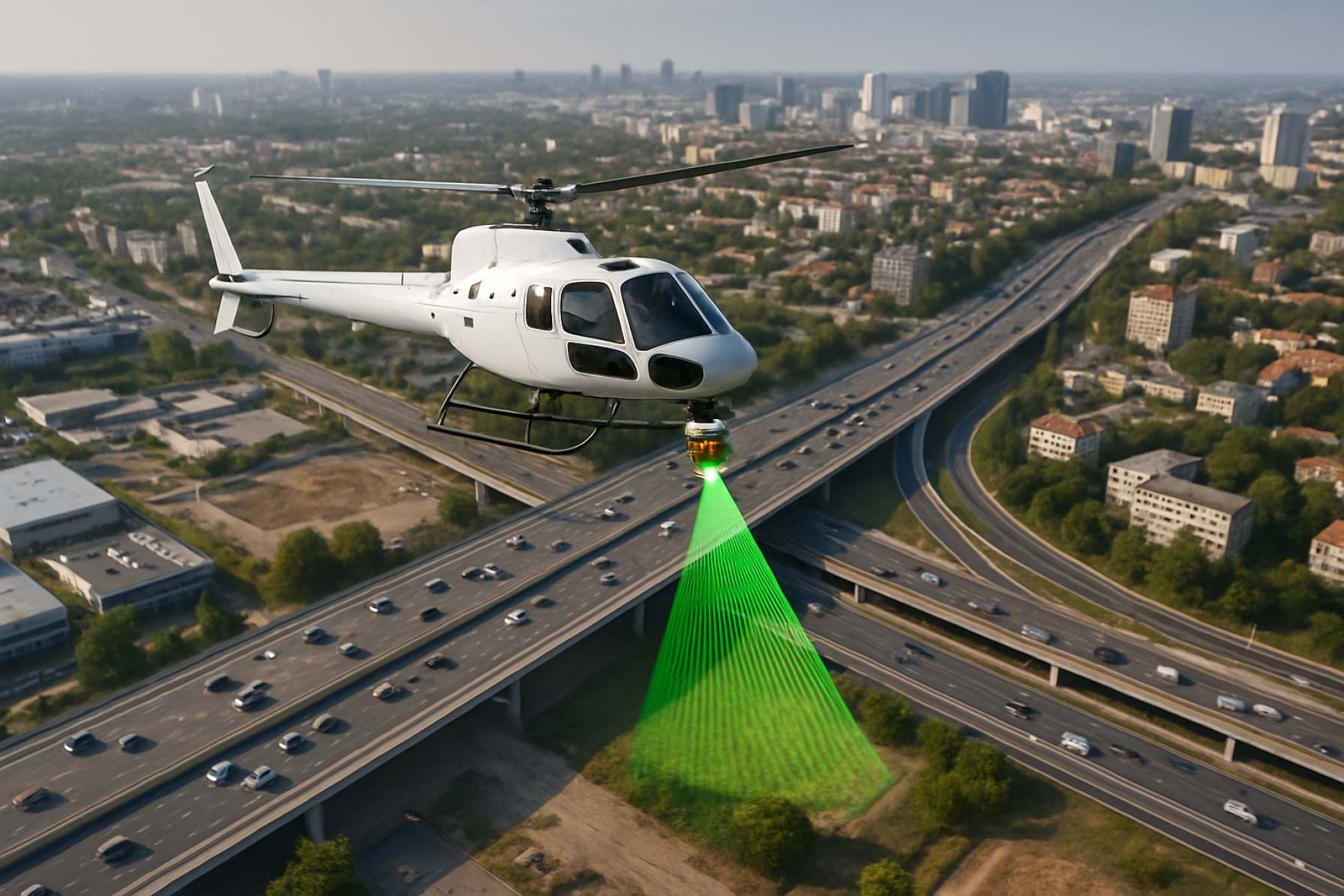Aerial Lidar Mapping Systems Market Report 2025: In-Depth Analysis of Growth Drivers, Technology Innovations, and Global Opportunities. Explore Market Size, Key Players, and Forecasts Through 2030.
- Executive Summary & Market Overview
- Key Technology Trends in Aerial Lidar Mapping Systems
- Competitive Landscape and Leading Players
- Market Growth Forecasts (2025–2030) and CAGR Analysis
- Regional Market Analysis and Emerging Hotspots
- Future Outlook: Innovations and Market Evolution
- Challenges, Risks, and Strategic Opportunities
- Sources & References
Executive Summary & Market Overview
Aerial Lidar (Light Detection and Ranging) mapping systems are advanced remote sensing technologies that use laser pulses from airborne platforms—such as drones, helicopters, or fixed-wing aircraft—to generate high-resolution, three-dimensional representations of the Earth’s surface. These systems are pivotal in applications ranging from topographic mapping and forestry management to urban planning, infrastructure development, and disaster response.
The global market for aerial Lidar mapping systems is experiencing robust growth, driven by increasing demand for precise geospatial data across multiple sectors. According to MarketsandMarkets, the Lidar market is projected to reach USD 3.7 billion by 2025, with aerial Lidar representing a significant and rapidly expanding segment. Key growth factors include the proliferation of smart city initiatives, the expansion of autonomous vehicle testing, and the need for efficient environmental monitoring.
Technological advancements are further propelling market expansion. The integration of Lidar with high-resolution cameras, real-time data processing, and AI-driven analytics has enhanced the accuracy, speed, and versatility of aerial mapping solutions. Companies such as Leica Geosystems, RIEGL, and Teledyne Optech are at the forefront, offering systems capable of capturing detailed terrain models even in challenging environments such as dense forests or urban canyons.
Regionally, North America and Europe dominate the aerial Lidar mapping market, attributed to substantial investments in infrastructure, environmental conservation, and government-sponsored geospatial projects. However, the Asia-Pacific region is expected to witness the fastest growth through 2025, fueled by rapid urbanization, infrastructure development, and increasing adoption of advanced mapping technologies in countries like China, India, and Japan (Fortune Business Insights).
- Key Market Drivers: Infrastructure modernization, disaster management, precision agriculture, and environmental monitoring.
- Challenges: High initial investment, regulatory hurdles for aerial operations, and data privacy concerns.
- Opportunities: Integration with UAVs, cloud-based data analytics, and expansion into emerging markets.
In summary, the aerial Lidar mapping systems market in 2025 is characterized by technological innovation, expanding applications, and strong growth prospects, positioning it as a critical enabler of next-generation geospatial intelligence.
Key Technology Trends in Aerial Lidar Mapping Systems
Aerial Lidar mapping systems are undergoing rapid technological evolution, driven by advancements in sensor miniaturization, data processing, and integration with complementary geospatial technologies. As of 2025, several key technology trends are shaping the landscape of aerial Lidar mapping, enhancing both the quality and efficiency of data acquisition for applications in urban planning, forestry, infrastructure monitoring, and disaster management.
- Miniaturization and Weight Reduction: The development of lighter and more compact Lidar sensors is enabling deployment on a wider range of aerial platforms, particularly unmanned aerial vehicles (UAVs) and drones. This trend is reducing operational costs and expanding access to high-resolution mapping in previously inaccessible or hazardous areas. Companies such as Leica Geosystems and RIEGL have introduced lightweight Lidar systems specifically designed for UAV integration.
- Increased Point Cloud Density and Accuracy: Advances in laser pulse rates and receiver sensitivity are resulting in denser and more accurate point clouds. Modern systems can now achieve point densities exceeding 2 million points per second, significantly improving the granularity of topographic and object detection. This is particularly valuable for applications requiring fine detail, such as power line inspection and vegetation analysis (Geospatial World).
- Real-Time Data Processing and AI Integration: The integration of artificial intelligence (AI) and edge computing is enabling real-time data processing and feature extraction directly onboard aerial platforms. This reduces the time from data acquisition to actionable insights, supporting time-sensitive operations such as emergency response and rapid infrastructure assessment (MarketsandMarkets).
- Multi-Sensor Fusion: Combining Lidar with other sensors—such as RGB cameras, hyperspectral imagers, and thermal sensors—provides richer datasets and enhances object classification and change detection capabilities. This trend is driving the adoption of integrated mapping solutions for complex environments (Teledyne Optech).
- Cloud-Based Data Management: The proliferation of cloud platforms is streamlining the storage, sharing, and collaborative analysis of massive Lidar datasets. Cloud-based workflows are becoming standard, enabling remote teams to access and process data efficiently (Esri).
These technology trends are collectively driving the adoption of aerial Lidar mapping systems across diverse sectors, setting new benchmarks for data quality, operational flexibility, and analytical capability in 2025.
Competitive Landscape and Leading Players
The competitive landscape of the aerial LiDAR mapping systems market in 2025 is characterized by a mix of established geospatial technology firms, specialized LiDAR manufacturers, and emerging startups leveraging advancements in sensor miniaturization and data analytics. The market is moderately consolidated, with a few key players holding significant market shares, while numerous regional and niche companies compete on innovation, customization, and service integration.
Leading the global market are companies such as Leica Geosystems (a Hexagon company), Teledyne Optech, and RIEGL Laser Measurement Systems. These firms have established reputations for high-precision airborne LiDAR solutions, robust software ecosystems, and global service networks. Their competitive advantage lies in continuous R&D investment, integration of AI-driven data processing, and partnerships with aerial survey providers and government agencies.
- Leica Geosystems maintains a strong presence through its Leica ALS series, known for high-density point cloud generation and integration with GNSS/IMU systems. The company’s focus on end-to-end workflow solutions and cloud-based data management platforms has reinforced its leadership in large-scale infrastructure and environmental monitoring projects.
- Teledyne Optech is recognized for its Galaxy and ALTM series, which offer multi-sensor integration (including hyperspectral and thermal imaging) and advanced automation features. Teledyne’s global reach and strategic acquisitions have expanded its footprint in North America, Europe, and Asia-Pacific.
- RIEGL stands out for its waveform-LiDAR technology, enabling superior vegetation penetration and topographic mapping in challenging environments. RIEGL’s focus on lightweight, UAV-compatible systems has positioned it well in the rapidly growing drone-based mapping segment.
Other notable players include SureStar (China), VQ (Austria), and LiDAR USA, each offering regionally tailored solutions and competitive pricing. The market is also witnessing increased activity from technology giants such as GE and Trimble, who are integrating LiDAR with broader geospatial and construction management platforms.
Strategic collaborations, mergers, and acquisitions are shaping the competitive dynamics, as companies seek to expand their technological capabilities and global reach. The entry of new players focusing on AI-powered analytics and cloud-based delivery models is expected to intensify competition, particularly in applications such as smart city planning, disaster management, and autonomous vehicle navigation.
Market Growth Forecasts (2025–2030) and CAGR Analysis
The aerial LiDAR mapping systems market is poised for robust growth between 2025 and 2030, driven by expanding applications in infrastructure development, environmental monitoring, urban planning, and autonomous navigation. According to recent projections, the global aerial LiDAR market is expected to achieve a compound annual growth rate (CAGR) of approximately 15% during this period, with market size estimates reaching over USD 4 billion by 2030, up from around USD 1.8 billion in 2024 MarketsandMarkets.
Key growth drivers include the increasing adoption of high-resolution geospatial data for smart city initiatives, the modernization of transportation infrastructure, and the rising demand for precision agriculture and forestry management. The integration of LiDAR with advanced technologies such as artificial intelligence (AI), machine learning, and cloud-based data processing is expected to further accelerate market expansion, enabling faster and more accurate data analysis for end-users Grand View Research.
Regionally, North America is anticipated to maintain its leadership position through 2025–2030, supported by significant investments in infrastructure and the presence of major LiDAR technology providers. However, the Asia-Pacific region is projected to exhibit the highest CAGR, fueled by rapid urbanization, government-backed infrastructure projects, and increasing adoption of unmanned aerial vehicles (UAVs) for mapping and surveying purposes Fortune Business Insights.
- Infrastructure and Construction: The demand for aerial LiDAR in large-scale construction and transportation projects is expected to surge, as governments and private entities prioritize digital mapping for planning and monitoring.
- Environmental Applications: Climate change mitigation and disaster management initiatives will drive the use of LiDAR for topographic mapping, flood modeling, and forest inventory.
- Technological Advancements: Ongoing improvements in sensor accuracy, miniaturization, and data processing capabilities will lower operational costs and expand the addressable market.
Overall, the aerial LiDAR mapping systems market is set for dynamic growth through 2030, with technological innovation and expanding end-use cases underpinning a strong CAGR and significant revenue opportunities for industry stakeholders.
Regional Market Analysis and Emerging Hotspots
The global market for aerial LiDAR mapping systems is experiencing dynamic regional shifts, with growth hotspots emerging in both established and developing economies. In 2025, North America continues to dominate the market, driven by robust investments in infrastructure modernization, disaster management, and autonomous vehicle development. The United States, in particular, benefits from strong federal and state funding for geospatial data acquisition and the presence of leading technology providers such as Hexagon AB and Teledyne Technologies. Canada is also expanding its adoption of aerial LiDAR for forestry management and environmental monitoring, supported by government initiatives to enhance climate resilience.
Europe remains a significant market, with countries like Germany, the United Kingdom, and France leveraging aerial LiDAR for smart city projects, transportation planning, and flood risk assessment. The European Union’s focus on digital infrastructure and sustainability, as outlined in the Digital Europe Programme, is accelerating the integration of advanced mapping technologies across member states. Additionally, the region’s stringent environmental regulations are prompting increased use of LiDAR for precision agriculture and renewable energy site planning.
Asia-Pacific is emerging as the fastest-growing region, propelled by rapid urbanization, infrastructure expansion, and government-backed digital transformation initiatives. China leads the region, with significant investments in smart city development and high-speed rail networks, supported by domestic LiDAR manufacturers such as RIEGL and Leica Geosystems. India and Southeast Asian countries are also investing in aerial LiDAR for land surveying, disaster management, and resource exploration, with support from international development agencies and public-private partnerships.
- Middle East and Africa: Adoption is accelerating, particularly in the Gulf Cooperation Council (GCC) countries, where aerial LiDAR is used for urban planning, oil and gas exploration, and infrastructure security. South Africa is leveraging LiDAR for mining and environmental monitoring.
- Latin America: Brazil and Mexico are leading the region, utilizing aerial LiDAR for forestry management, agriculture, and urban development, often in collaboration with international organizations such as the World Bank.
In summary, while North America and Europe remain mature markets, Asia-Pacific and select regions in the Middle East, Africa, and Latin America are emerging as new growth hotspots for aerial LiDAR mapping systems in 2025, driven by diverse applications and increasing government and private sector investments.
Future Outlook: Innovations and Market Evolution
The future outlook for aerial LiDAR mapping systems in 2025 is shaped by rapid technological innovation, expanding application domains, and evolving market dynamics. As industries increasingly demand high-resolution geospatial data, LiDAR technology is expected to undergo significant advancements in sensor miniaturization, data processing speed, and integration with complementary technologies such as artificial intelligence (AI) and cloud computing.
One of the most notable trends is the proliferation of lightweight, high-precision LiDAR sensors suitable for deployment on unmanned aerial vehicles (UAVs) and drones. This shift is reducing operational costs and enabling more frequent, flexible data collection, particularly for sectors like construction, agriculture, and environmental monitoring. According to MarketsandMarkets, the global drone LiDAR market is projected to grow at a double-digit CAGR through 2025, driven by these technological improvements and the increasing adoption of UAVs for mapping and surveying tasks.
Another key innovation is the integration of AI and machine learning algorithms into LiDAR data processing workflows. These technologies are enhancing the automation of feature extraction, object recognition, and change detection, significantly reducing the time and expertise required to derive actionable insights from raw point cloud data. Companies such as Hexagon AB and Leica Geosystems are investing heavily in software platforms that leverage AI to streamline data analysis and improve accuracy.
- Cloud-based platforms: The adoption of cloud computing is facilitating real-time data sharing and collaborative analysis, making LiDAR-derived information more accessible to stakeholders across geographies.
- Multi-sensor fusion: Combining LiDAR with photogrammetry, hyperspectral imaging, and GNSS technologies is yielding richer datasets and more comprehensive mapping solutions, particularly for urban planning and infrastructure management.
- Regulatory evolution: As regulatory frameworks for UAV operations mature, especially in North America and Europe, the market is expected to see fewer operational barriers and greater commercial deployment of aerial LiDAR systems (Federal Aviation Administration).
Looking ahead to 2025, the aerial LiDAR mapping systems market is poised for robust growth, underpinned by continuous innovation, expanding end-user applications, and supportive regulatory environments. These factors are expected to drive both the volume and value of LiDAR-based mapping projects worldwide, solidifying the technology’s role as a cornerstone of modern geospatial intelligence.
Challenges, Risks, and Strategic Opportunities
The aerial LiDAR mapping systems market in 2025 faces a complex landscape of challenges, risks, and strategic opportunities as technological advancements and market demands evolve. One of the primary challenges is the high initial investment and operational costs associated with LiDAR equipment, aircraft, and data processing infrastructure. These costs can be prohibitive for smaller firms and limit market penetration in developing regions. Additionally, the integration of LiDAR data with other geospatial datasets requires advanced software and skilled personnel, further increasing operational complexity and costs.
Regulatory risks also persist, particularly regarding airspace management and privacy concerns. As governments tighten regulations on unmanned aerial vehicles (UAVs) and data collection, companies must navigate a shifting compliance landscape. For example, the European Union’s General Data Protection Regulation (GDPR) and evolving U.S. Federal Aviation Administration (FAA) guidelines can impact project timelines and operational flexibility (Federal Aviation Administration).
Data security and integrity represent additional risks. The vast amounts of high-resolution geospatial data generated by aerial LiDAR systems are attractive targets for cyberattacks. Ensuring robust cybersecurity measures and secure data storage is critical, especially for projects involving sensitive infrastructure or government contracts (National Institute of Standards and Technology).
Despite these challenges, significant strategic opportunities are emerging. The growing adoption of digital twin technology in urban planning, infrastructure monitoring, and environmental management is driving demand for high-precision LiDAR data (MarketsandMarkets). The expansion of 5G networks and cloud computing is enabling faster data transmission and real-time processing, making LiDAR solutions more accessible and scalable.
- Partnerships between LiDAR system providers and cloud service companies can streamline data workflows and reduce costs.
- Integration with AI and machine learning algorithms offers new possibilities for automated feature extraction and predictive analytics.
- Emerging markets in Asia-Pacific and Latin America present untapped growth potential, particularly for infrastructure development and disaster management applications (Grand View Research).
In summary, while aerial LiDAR mapping systems in 2025 must contend with high costs, regulatory hurdles, and data security risks, the sector is poised for growth through technological innovation, strategic partnerships, and expansion into new geographic and application markets.
Sources & References
- MarketsandMarkets
- Teledyne Optech
- Fortune Business Insights
- Geospatial World
- Esri
- VQ
- GE
- Trimble
- Grand View Research
- Hexagon AB
- Teledyne Technologies
- Digital Europe Programme
- World Bank
- National Institute of Standards and Technology











